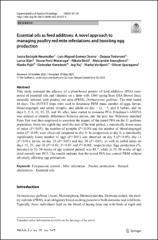Essential oils as feed additives: A novel approach to managing poultry red mite infestations and boosting egg production

View/
Date
2025Author
Bošnjak-Neumüller, Jasna
Gomez Osorio, Luis-Miguel
Todorović, Dajana
Ilijin, Larisa
Perić-Mataruga, Vesna
Delić, Nikola
Stanojković, Aleksandar
Pajić, Marko
Knežević, Slobodan
Raj, Jog
Vasiljević, Marko
Sparagano, Olivier
Metadata
Show full item recordAbstract
This study assessed the efficacy of a plant-based premix of feed additives (PFA) composed
of essential oils and vitamins on a farm with 1560 laying hens (ISA Brown line),
naturally infested with poultry red mite (PRM), Dermanyssus gallinae. The trial lasted
44 days. The AVIVET traps were used to determine PRM mass, number of eggs, larvae,
blood-engorged and unfed nymphs, and adults on day − 12, − 5, and 0 before, and on
days 2, 5, 8, 11, 15, 23, and 30, after, hens started to consume PFA. Friedman’s ANOVA
was utilised to identify differences between means, and the post hoc Wilcoxon matched
Pairs Test was then employed to ascertain the impact of the tested PFA on the D. gallinae
population. From the eighth day until the end of the trial period, a statistically lower mass
of mites (P < 0.05), the number of nymphs (P < 0.05) and the number of blood-engorged
mites (P < 0.05) were observed compared to day 0. In comparison to day 0, a statistically
significantly lower number of eggs (P < 0.01) was observed on day 5 (P < 0.05), day 11
(P < 0.01), larvae on day 23 (P < 0.05) and day 30 (P < 0.01), as well as unfed mites on
days 15, 23, and 30 (P < 0.01, P < 0.01 and P < 0.001, respectively). Egg production (%,
hen-day) in 52–54 weeks of age (control period) was 88.7, while in 55–58 weeks of age
(trial period) was 89.5. The results indicate that the tested PFA can control PRM without
adversely affecting egg production.
